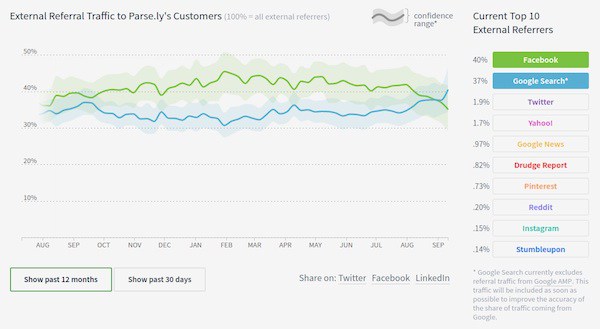Well, it’s happening. Facebook – in spite of promises made to publishers – has dipped below Google as the biggest source of referral traffic.
“Parse.ly data shows that across its 2,500-site network, Facebook declined as a source of referral traffic to publishers, with Google surpassing the social network to become the biggest referrer,” writes Lucia Moses in Digiday. “Social analytics firm BuzzSumo, meanwhile, reported that Facebook engagement across 880 million posts from publishers and brands fell 20 percent since January.”

Image source: Digiday
What’s happening here? There are a few different things going on that are having an impact.
“The usual theories given for the decline range from Facebook’s algorithm changes that disadvantage publishers to a desire by Facebook to get publishers to pay for promotion to its emphasis on video viewed directly on the platform, leaving less room for publishers’ links back to their own sites,” Moses explains.
(There’s also the possibility that a huge number of users are fed up with the fake news and shoddy content on the social stream. And let’s not forget that our newsfeeds look more like a string of commercials than the personal connections we loved about the platform. It’s no wonder that social sharing is down there.)
And while many brands are playing along, especially with video ad programs, publishers are seeing little return. Some are even pulling the plug on their involvement with Instant Articles; while others are seeing significant drops in organic traffic to their own sites like we noted earlier today with Mic.com.
Facebook, for its part, wants to keep visitors inside its walled garden. This has been obvious since they announced the Instant Articles program. Publisher traffic sinks in exchange for eyeballs and – at least theoretically – ad revenue.
“They’re definitely prioritizing video and keeping the audience within the Facebook platform as much as possible, and it is really a challenge for media brands,” said Scott Cherkin of Complex Networks. “Video is a distributed medium and mostly consumed on social platforms, not on publisher sites, so it’s important to think about audience development differently based on whether it’s text/photo or video. There was a moment recently when, in the shift to video, it was fashionable for some publishers to consider embracing a fully-distributed model but with so much change, I think the tide has shifted back to wanting to grow a one-to-one relationship with the audience on a site(s) they control.”
Facebook, meantime, knows it’s fallen out of favor with many publishers. As Moses notes, problems like the video metrics dust-up and dodgy viewership numbers left many publishers wondering if the new mid-roll video ads will be worth pursuing. So Zuckerberg et.al. are putting some ideas out to publishers that might smooth the waters.
“it’s been making moves — some symbolic, some substantive — to restore confidence and help publishers’ business, from listening tours to more avenues to monetize Instant Articles to a planned test of subscription sales,” Moses notes.
Publishers are listening, of course – they almost have to, having made the commitment to social media and their general fear of not playing along. But there’s a lot of concern out there for the size and scope of Facebook’s ownership of content distribution: Between Facebook and Google, they hold a 99% duopoly on digital advertising.
Michael Silberman of New York Media shares a common sentiment for many publishers: “We continue to be wary of Facebook and its enormous influence. We think the duopoly’s power and the total share of digital revenue controlled by Facebook and Google is a big problem for the entire publishing industry. We are seeing a higher willingness to engage and hear feedback, but we’ll see what they are actually willing to change.”
In the meantime, publishers are searching for control over their own audience reach and their reader engagement. It seems the tradeoff – giving away that control in exchange for lackluster ad revenues – wasn’t worth it after all.
